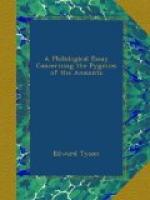[Footnote A: Morgenblatt, 1853 (quoted by Schaafhausen, Arch. f. Anth., 1866, p. 166).]
[Footnote B: London, Nutt, 1891.]
[Footnote C: Nature, 1892, ii. 616.]
[Footnote A: Nature, 1892, i. 269.]
Finally, in Madagascar it is possible that there may be a dwarf race. Oliver[A] states that “the Vazimbas are supposed to have been the first occupants of Ankova. They are described by Rochon, under the name of Kunios, as a nation of dwarfs averaging three feet six inches in stature, of a lighter colour than the Negroes, with very long arms and woolly hair. As they were only described by natives of the coast, and have never been seen, it is natural to suppose that these peculiarities have been exaggerated; but it is stated that people of diminutive size still exist on the banks of a certain river to the south-west.” There are many tumuli of rude work and made of rough stones throughout the country, which are supposed to be their tombs. In idolatrous days, says Mullens,[B] the Malagasy deified the Vazimba, and their so-called tombs were the most sacred objects in the country. In this account may be found further evidence in favour of Mr. Gomme’s theory, to which attention has already been called.
[Footnote A: Anthrop. Memoirs, iii. 1.]
[Footnote B: Jour. Anthrop. Inst., v. 181.]
In the great continent of America there does not appear to have ever been, so far as our present knowledge teaches, any pigmy race. Dr. Brinton, the distinguished American ethnologist, to whom I applied for information on this point, has been good enough to write to me that, in his opinion, there is no evidence of any pigmy race in America. The “little people” of the “stone graves” in Tennessee, often supposed to be such, were children, as the bones testify. The German explorer Hassler has alleged the existence of a pigmy race in Brazil, but testimony is wanting to support such allegation. There are two tribes of very short but not pigmy stature in America, the Yahgans of Tierra del Fuego and the Utes of Colorado, but both of these average over five feet.
Leaving aside for the moment the Lapps, to whom I shall return, there does not appear to have been at any time a really pigmy race in Europe, so far as any discoveries which have been made up to the present time show. Professor Topinard, whose authority upon this point cannot be gainsaid, informs me that the smallest race known to him in Central Europe is that of the pre-historic people of the Lozere, who were Neolithic troglodytes, and are represented probably at the present day by some of the peoples of South Italy and Sardinia. Their average stature was about five feet two inches. This closely corresponds with what is known of the stature of the Platycnemic race of Denbighshire, the Perthi-Chwareu. Busk[A] says of them that they were of low stature, the mean height, deduced from the lengths of the long bones,




